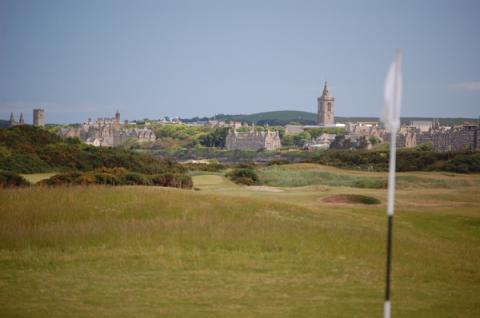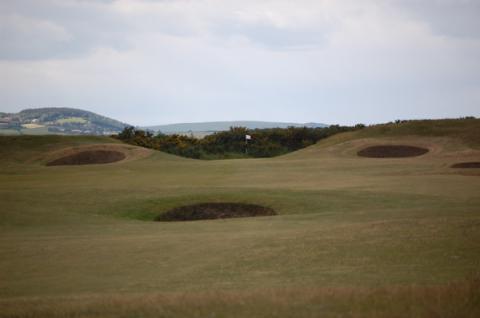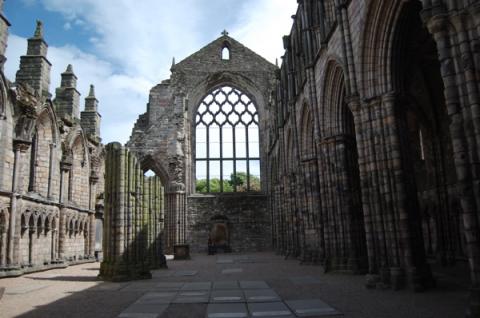
St. Andrews city views are everpresent from the New Course.
I came to Scotland with my son Tim with all but one day of our weeklong visit pre-booked for golf. I left one day open on the chance that we might get lucky and be picked from all the many ballots submitted for a round at the Old Course Saturday (today). Yesterday, we filled out the form at the caddie station by the 2 p.m. deadline, handed it in and then trotted off to play the St. Andrews New Course, which at 122 years is not exactly new - just not as old as the Old Course. St. Andrews Links pulls the ballots after 2 p.m. and announces the results at 4 p.m.
After our round on the New, we stopped in the clubhouse and, after a nail biting search by the lady behind the counter, we found our names down for a two-ball - we will likely be joined by two walk-ons - at 2:10 p.m. today. I
We started our golf in the Kingdom at the Crail Balcomie Links, just two miles from the wonderful two-bedroom cottage where we are staying in the tiny fishing village of Crail. Balcomie is one of the oldest courses in the world, a true links with knockout views of the sea from the links land above. My son Tim, the golf architect aficionado, will follow in the coming days with a review of Crail Balcomie Links (Note: If he seems less than enthusiastic about the challenge, it is only because he shot a sterling 70 with a chip in for eagle).
The Crail Library has the only Internet connection in town, and it is open for limited hours only three days a week. I had to sign up for a local library card to log on, but the Internet connection was spotty and slow when it
 worked. I am sending this article to the web site from a coffee shop in St. Andrews (you cannot find a cup of real coffee in Crail - just instant - although the folks at the Golf Hotel in town did not charge me for the cup early this morning).
worked. I am sending this article to the web site from a coffee shop in St. Andrews (you cannot find a cup of real coffee in Crail - just instant - although the folks at the Golf Hotel in town did not charge me for the cup early this morning). Crail, though rustic, is perfectly situated for a golf week. To the north, just 10 minutes away, are the links at Kingsbarn and the Fairmont Hotel (18 by Bruce Devlin, 18 by Sam Torrance). On the approach to St. Andrews, just eight miles from Crail, is the new and widely celebrated St. Andrews Castle Course, designed by the Scottish wunderkind David McLay Kidd, and then of course all the renowned courses of St. Andrews are a few miles beyond. To the south of Crail are such unheralded gems - not unheralded by those who play a lot of Scottish golf - at Lundin Links and Elie, which are on our list for Sunday and Monday. Tuesday we are set to play Scottscraig, one of the 10 oldest courses in the world, just north of St. Andrews, before winding up our week with another go at Balcomie.
Although I am gaga about being in Scotland for a week of golf, my son has really hit the lottery. His aunt in London has arranged a belated birthday present for him, a round of golf at the famed Royal Sunningdale outside the city, after we arrive there at the end of the week. Lucky kid; he gets a week of golf in Scotland, including a round at the Old Course, at an age 42 years earlier than his father's first sojourn to the Old Sod. I sure hope he can wangle me an invite at Sunningdale. What was it the poet Wordsworth wrote? "Child is father to the man."

Face of the New Course: The sod bunkers protecting the 8th green at the New Course appear almost to be smiling. You won't be should you find one of them.

























